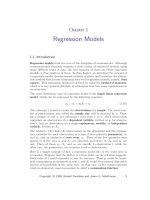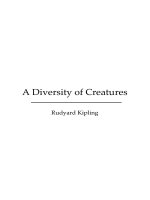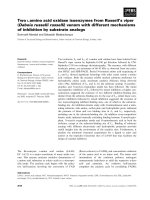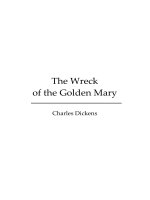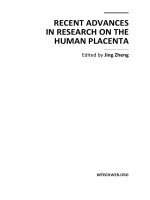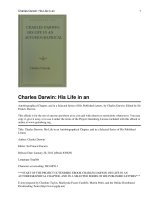The Foundations of the Origin of Species, by Charles Darwin pdf
Bạn đang xem bản rút gọn của tài liệu. Xem và tải ngay bản đầy đủ của tài liệu tại đây (1.89 MB, 797 trang )
The Project Gutenberg EBook of The
Foundations of the Origin of Species, by
Charles Darwin
This eBook is for the use of anyone
anywhere at no cost and with
almost no restrictions whatsoever. You may
copy it, give it away or
re-use it under the terms of the Project
Gutenberg License included
with this eBook or online at
www.gutenberg.org
Title: The Foundations of the Origin of
Species
Two Essays written in 1842 and 1844
Author: Charles Darwin
Editor: Francis Darwin
Release Date: September 22, 2007 [EBook
#22728]
Language: English
*** START OF THIS PROJECT GUTENBERG EBOOK
FOUNDATIONS ORIGIN OF SPECIES ***
Produced by Geetu Melwani, David Clarke,
LN Yaddanapudi
and the Online Distributed Proofreading
Team at
(This file was
produced from images
generously made available by The Internet
Archive/Canadian
Libraries)
THE
FOUNDATIONS
OF THE
ORIGIN OF
SPECIES
CAMBRIDGE UNIVERSITY PRESS
London: FETTER LANE, E.C.
C. F. CLAY, Manager
Edinburgh: 100, PRINCES STREET
ALSO
London: H. K. LEWIS, 136, GOWER STREET, W.C.
Berlin: A. ASHER AND CO.
Leipzig: F. A. BROCKHAUS
New York: G. P. PUTNAM’S SONS
Bombay and Calcutta: MACMILLAN AND Co., Ltd.
All rights reserved
THE
FOUNDATIONS
OF THE
ORIGIN OF
SPECIES
TWO ESSAYS
WRITTEN IN 1842
AND 1844
by
CHARLES DARWIN
Edited by his son
FRANCIS DARWIN
Honorary Fellow of Christ's College
Cambridge:
at the University Press
1909
Astronomers might formerly have
said that God ordered each planet to
move in its particular destiny. In
same manner God orders each animal
created with certain form in certain
country. But how much more simple
and sublime power,—let attraction
act according to certain law, such are
inevitable consequences,—let
animal«s» be created, then by the
fixed laws of generation, such will
be their successors.
From Darwin’s Note Book, 1837,
p. 101.
TO THE MASTER AND FELLOWS
OF CHRIST’S COLLEGE, THIS
BOOK IS DEDICATED BY THE
EDITOR IN TOKEN OF RESPECT
AND GRATITUDE
CONTENTS
ESSAY OF 1842
Introduction
PART I
§ i. On variation under
domestication, and on the principles
of selection
§ ii. On variation in a state of nature
and on the natural means of selection
§ iii. On variation in instincts and
other mental attributes
PART II
§§ iv. and v. On the evidence from
Geology. (The reasons for combining
the two sections are given in the
Introduction)
§ vi. Geographical distribution
§ vii. Affinities and classification
§ viii. Unity of type in the great
classes
§ ix. Abortive organs
§ x. Recapitulation and conclusion
ESSAY OF 1844
PART I
CHAPTER I
ON THE VARIATION OF ORGANIC
BEINGS UNDER DOMESTICATION;
AND ON THE PRINCIPLES OF
SELECTION.
Variation
On the hereditary tendency
Causes of Variation
On Selection
Crossing Breeds
Whether our domestic races have
descended from one or more wild
stocks
Limits to Variation in degree and
kind
In what consists Domestication
Summary
CHAPTER II
ON THE VARIATION OF ORGANIC
BEINGS IN A WILD STATE; ON THE
NATURAL MEANS OF SELECTION;
AND ON THE COMPARISON OF
DOMESTIC RACES AND TRUE
SPECIES.
Variation
Natural means of Selection
Differences between “Races” and
“Species”:—first, in their trueness or
variability
Difference between “Races” and
“Species” in fertility when crossed
Causes of Sterility in Hybrids
Infertility from causes distinct from
hybridisation
Points of Resemblance between
“Races” and “Species”
External characters of Hybrids and
Mongrels
Summary
Limits of Variation
CHAPTER III
ON THE VARIATION OF INSTINCTS
AND OTHER MENTAL ATTRIBUTES
UNDER DOMESTICATION AND IN A
STATE OF NATURE; ON THE
DIFFICULTIES IN THIS SUBJECT;
AND ON ANALOGOUS DIFFICULTIES
WITH RESPECT TO CORPOREAL
STRUCTURES.
Variation of mental attributes under
domestication
Hereditary habits compared with
instincts
Variation in the mental attributes of
wild animals
Principles of Selection applicable to
instincts
Difficulties in the acquirement of
complex instincts by Selection
Difficulties in the acquirement by
Selection of complex corporeal
structures
PART II
ON THE EVIDENCE FAVOURABLE
AND OPPOSED TO THE VIEW THAT
SPECIES ARE NATURALLY FORMED
RACES, DESCENDED FROM
COMMON STOCKS.
CHAPTER IV
ON THE NUMBER OF
INTERMEDIATE FORMS REQUIRED
ON THE THEORY OF COMMON
DESCENT; AND ON THEIR ABSENCE
IN A FOSSIL STATE
CHAPTER V
GRADUAL APPEARANCE AND
DISAPPEARANCE OF SPECIES.
Gradual appearance of species
Extinction of species
CHAPTER VI
ON THE GEOGRAPHICAL
DISTRIBUTION OF ORGANIC BEINGS
IN PAST AND PRESENT TIMES.
SECTION FIRST
Distribution of the inhabitants in the
different continents
Relation of range in genera and
species
Distribution of the inhabitants in the
same continent
Insular Faunas
Alpine Floras
Cause of the similarity in the floras
of some distant mountains
Whether the same species has been
created more than once
On the number of species, and of the
classes to which they belong in
different regions
SECOND SECTION
Geographical distribution of extinct
organisms
Changes in geographical distribution
Summary on the distribution of living
and extinct organic beings
SECTION THIRD
An attempt to explain the foregoing
laws of geographical distribution, on
the theory of allied species having a
common descent
Improbability of finding fossil forms
intermediate between existing
species
CHAPTER VII
ON THE NATURE OF THE AFFINITIES
AND CLASSIFICATION
OF ORGANIC BEINGS.
Gradual appearance and
disappearance of groups
What is the Natural System?
On the kind of relation between
distinct groups
Classification of Races or Varieties
Classification of Races and Species
similar
Origin of genera and families
CHAPTER VIII
UNITY OF TYPE IN THE GREAT
CLASSES; AND MORPHOLOGICAL
STRUCTURES.
Unity of Type
Morphology
Embryology
Attempt to explain the facts of
embryology
On the graduated complexity in each
great class
Modification by selection of the
forms of immature animals
Importance of embryology in
classification
Order in time in which the great
classes have first appeared
CHAPTER IX
ABORTIVE OR RUDIMENTARY
ORGANS.
The abortive organs of Naturalists
The abortive organs of Physiologists
Abortion from gradual disuse
CHAPTER X
RECAPITULATION AND
CONCLUSION.
Recapitulation
Why do we wish to reject the Theory
of Common Descent?
Conclusion
Index
Portrait
Facsimile
We know from the contents of Charles
Darwin’s Note Book of 1837 that he was
at that time a convinced Evolutionist
{1}
.
Nor can there be any doubt that, when he
started on board the Beagle, such opinions
as he had were on the side of
immutability. When therefore did the
current of his thoughts begin to set in the
direction of Evolution?
We have first to consider the factors
that made for such a change. On his
departure in 1831, Henslow gave him vol.
i. of Lyell's Principles, then just
published, with the warning that he was
not to believe what he read
{2}
. But believe
he did, and it is certain (as Huxley has
forcibly pointed out
{3}
) that the doctrine of
uniformitarianism when applied to
Biology leads of necessity to Evolution. If
the extermination of a species is no more
catastrophic than the natural death of an
individual, why should the birth of a
species be any more miraculous than the
birth of an individual? It is quite clear that
this thought was vividly present to Darwin
when he was writing out his early thoughts
in the 1837 Note Book
{4}
:—
“Propagation explains why modern
animals same type as extinct, which is law
almost proved. They die, without they
change, like golden pippins; it is a
generation of species like generation of
